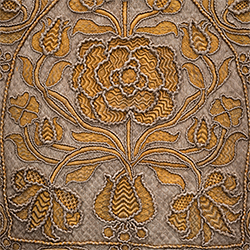
Mitre.
Vilnius (?), 17th c.
Vilnius Cathedral.
17th c. Golden floral Baroque
In the 17th century, the theme of the suffering of Christ in church art gave way to the idea of praising the glory of God with grandeur and sensuality, glitter of gold and richness of details. However, the greatest change in the decoration of liturgical vestments was the so far unprecedented dominance of floral ornaments. Liturgical vestments turned into magnificent flower gardens almost devoid of religious symbols.
Other liturgical vestments
Liturgical vestments were supplemented by other elements. The stole is a long band with broadened ends, which became an indispensable attribute of the Holy Mass in the 9th century. At that time, the maniple worn on the left forearm was also included among liturgical vestments. The mitre, a bishop’s headdress, became established in the liturgy in the 11th–12th century. The gremial was a magnificent cloth laid across the knees of a bishop at a certain point in the liturgy.

